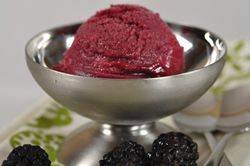|
|
| Subscribe Now |

|
|
Blackberry Sorbet Recipe:
1 cup (240 ml) water
1 1/4 cup (250 grams) granulated white sugar
1 pound (454 grams) frozen unsweetened blackberries
2 tablespoons lemon juice
2 tablespoons fruit liqueur (optional)
Note: If you taste the sorbet after freezing and find the amount of sugar is not right, adjust the level of sugar by adding a little sugar syrup (too little sugar in sorbet) or water (too much sugar in sorbet) and then refreeze the sorbet. The sorbet is not affected by thawing and refreezing.
|
|
Blackberry Sorbet: Bring the water to a boil in a small saucepan, remove from heat, and stir in the sugar until it is completely dissolved. Pour the sugar syrup into a heatproof container, cover and place in the refrigerator until completely chilled (about an hour).
Meanwhile, thaw the blackberries. When the blackberries are thawed, place in a blender or food processor and process until pureed. Add the blackberry puree to the chilled sugar syrup and then strain the mixture to remove the seeds. Add the lemon juice and liqueur (if using), cover and refrigerate until the mixture is thoroughly chilled.
Once the mixture is thoroughly chilled place in your ice cream machine and process according to the manufacturer's instructions. Once made, transfer to a chilled container and store in the freezer. When the sorbet becomes solid you may need to place it in the refrigerator for about 20 minutes so it is soft enough to serve.
If you do not have an ice cream machine you can 'still' freeze the sorbet. Pour the mixture into an 8 inch (20 cm) or 9 inch (23 cm) stainless steel pan (sorbets will freeze faster in stainless steel), cover with plastic wrap, and place in the freezer. After about 1 -1 1/2 hours check the sorbet. When the mixture is frozen to the point that a firm ring of ice has formed around the sides of the pan and there is a soft slush of sorbet in the center, remove from the freezer. Transfer the partially thawed sorbet to the food processor and process until the mixture is a uniform slush. This breaks up the large ice crystals that have formed on the sorbet. (This step is what gives the sorbet its wonderful fluffy texture.) Place the sorbet back into the pan, into the freezer, and repeat the process at least two more times at intervals of 1 - 1 1/2 hours. After the third processing return the sorbet to the freezer for about an hour before serving so the sorbet can be firm enough to serve.
Makes about 4 cups of sorbet.
|
|
Blackberries are big, and black, and shiny, and oh so sweet. The only problem is that they do not like to be picked. Waverley Root got it right when he said that the English name "brambleberry" is more fitting as "This name highlights the most impressive characteristic of the blackberry, the ferocity with which its fruit is defended by its thorns."
There are so many ways to use blackberries. Eating them raw with cream is the obvious choice as is pairing them with apples in crisps, pies and tarts. But another delicious and low fat alternative is to use them in this Blackberry Sorbet. Sorbet (pronounced Sor-BAY) is easier to make then ice cream, as it just involves mixing and freezing pureed fruit (fresh or frozen), a sugar syrup, and lemon juice. Blackberry sorbet has such a beautiful deep burgundy color that is wonderful when served in a pretty bowl by itself or in a tall parfait glass, alternating small scoops of vanilla ice cream with the blackberry sorbet.
Lastly, a note on sugar syrups. Sugar syrups are just a combination of sugar dissolved in water. The density of sugar (simple) syrups can vary depending on how they are going to be used. A heavy sugar syrup consists of about one part sugar to one part water (used here). A medium sugar syrup is about one part sugar to two parts water. And a light sugar syrup is about one part sugar to three parts water. Sugar syrups have all kinds of uses; soaking cakes and pastries (called a "soaking syrup" and a flavoring can be added such as extracts, juices or liqueurs), diluting fondants, poaching fruit, as a glaze, added to frostings and sorbets, and used in confectionery.